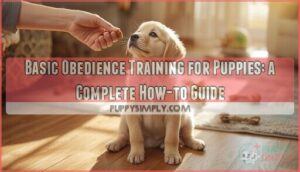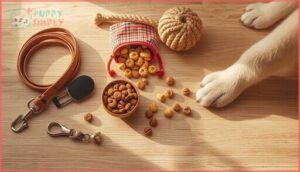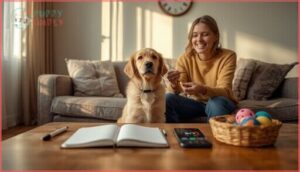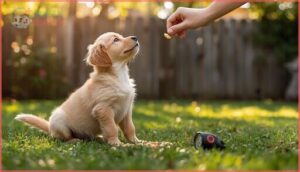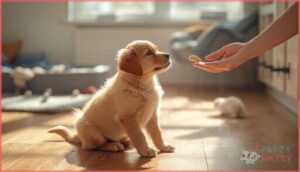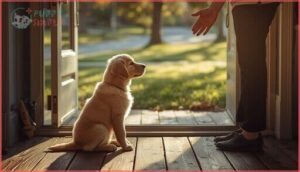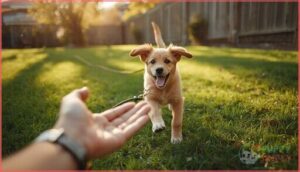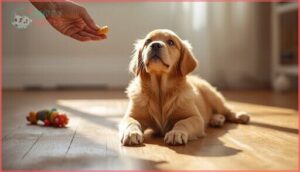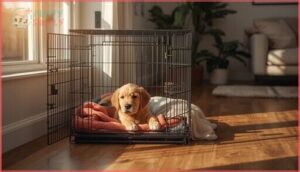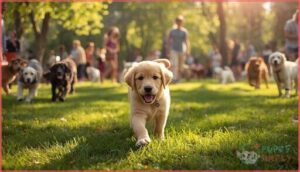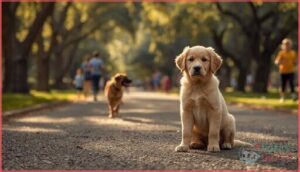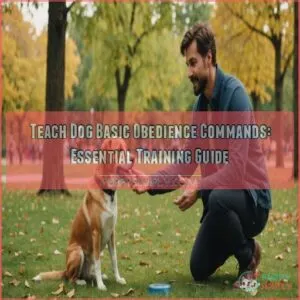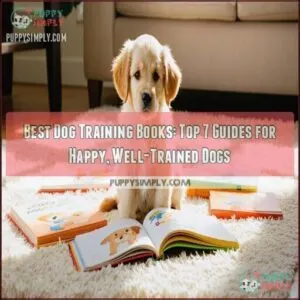This site is supported by our readers. We may earn a commission, at no cost to you, if you purchase through links.
Your eight-week-old puppy just destroyed your favorite shoes, ignores your pleas to “come,” and seems to think “sit” means “jump wildly at your face.” Sound familiar? Here’s the good news: puppies aren’t born knowing what you want—they need clear, consistent teaching from day one.
Basic obedience training transforms chaos into cooperation, but only if you know what works. Most new owners waste weeks on ineffective methods or wait too long to start, missing the critical early window when puppies absorb new information like sponges.
The right approach combines proper timing, simple techniques, and realistic expectations that set both you and your pup up for success.
Table Of Contents
- Key Takeaways
- When to Start Puppy Obedience Training
- Essential Equipment for Puppy Training
- Setting Up a Successful Training Routine
- Positive Reinforcement Techniques for Puppies
- Teaching Core Obedience Commands
- Housebreaking and Crate Training Basics
- Socialization and Managing Puppy Behavior
- Progressing and Maintaining Obedience Skills
- Frequently Asked Questions (FAQs)
- What is the first thing you should train your puppy?
- When should I start obedience training my puppy?
- What are puppy basic obedience commands?
- At what age should a puppy know basic commands?
- How do I choose the right obedience training class for my puppy?
- What is the difference between a dog trainer and a dog behaviorist?
- What types of obedience training classes are available for puppies?
- Can I train multiple puppies at once?
- How do I train a deaf puppy?
- Should I hire a professional dog trainer?
- Conclusion
Key Takeaways
- Start training between 8 and 12 weeks old with short 2-5 minute sessions, building good habits during the critical early window when puppies absorb information fastest.
- Use positive reinforcement exclusively—pair high-value treats with immediate praise and clicker signals to teach what you want instead of punishing what you don’t.
- Master the four essential commands (sit, stay, come, down) in distraction-free spaces first, then gradually increase difficulty with real-world distractions and distance.
- Establish consistent daily routines for potty breaks, meals, and training sessions across all family members to prevent confusion and speed up learning.
When to Start Puppy Obedience Training
You might wonder if your new puppy is too young for training, but here’s the good news: you can start right away.
The early weeks are actually the most important time to build good habits and confidence. Let’s look at the key timing factors that will set your puppy up for success.
Optimal Age for Beginning Training
Start basic training between 8 and 12 weeks, right after your puppy’s primary vaccinations. At this age, they’re ready to learn simple commands through positive reinforcement. Keep early sessions super short—just 2 to 5 minutes—to match those tiny attention spans.
Here’s your training timeline:
- 8-12 weeks: Begin formal obedience training
- 2-5 minutes: Ideal session length for young puppies
- Simple commands: Focus on one behavior at a time
- Scale gradually: Increase difficulty as your puppy develops
Early Socialization Importance
Beyond teaching commands, early socialization shapes your puppy’s entire personality. Exposing them to new sights, sounds, and friendly faces before 14 weeks reduces fear responses by up to 40%. That’s why puppy socialization matters—positive reinforcement during this window builds social bonds and aids sensory development through controlled puppy interactions. Effective communication of research findings, such as those on scientific writing techniques, is vital in various fields.
| Socialization Focus | Benefit |
|---|---|
| Environmental Exposure | 25% less noise sensitivity |
| Puppy Interactions | Higher long-term sociability |
| Varied Experiences | Better recall in adulthood |
| Early Social Bonds | Reduced fear-based behaviors |
Setting Realistic Expectations
Puppy training doesn’t happen overnight. Most puppies respond to basic training within two to four weeks of consistent practice, but you’ll see real progress between eight and sixteen weeks. Track your puppy’s success rate—aim for eight out of ten correct attempts before adding distractions.
Puppy development varies by breed and temperament, so adjust your owner expectations accordingly. Positive reinforcement works, but patience matters more than speed.
Consistent practice requires good writing research papers to track progress effectively.
Essential Equipment for Puppy Training
You don’t need a garage full of gear to train your puppy. A few basic tools will set you both up for success and make training sessions smoother and more enjoyable.
Let’s look at the essentials you’ll actually use.
Choosing The Right Collar and Leash
Your puppy’s first collar is like their introduction to the outside world—get it right, and everything else falls into place. A well-fitting flat buckle collar lets two fingers slide between the fabric and your pup’s neck, balancing collar safety with comfort. For basic training and loose-leash walking, pair it with a lightweight 4–6 foot leash.
- Chest strap option: A puppy chest strap reduces neck strain during early walk-on-a-leash sessions
- Leash Materials matter: Choose durable nylon or biothane for easy cleanup and longevity
- Check fit weekly: Puppies grow fast—adjust Training Equipment as needed
- Inspect regularly: Frayed edges or rust compromise safety during dog training
Selecting Training Treats and Toys
Picking the right reward can make or break your training success. Treat Selection starts with soft, pea-sized bites that your puppy can swallow quickly—think chicken or turkey. Toy Safety means checking for loose parts weekly and choosing durable, puppy-safe options.
Alternate treats and toys to keep your Reward Systems fresh and your puppy motivated.
| Reward Type | Best For | Safety Check |
|---|---|---|
| Soft protein treats | Quick reinforcement | Monitor daily calorie intake (5-10% max) |
| Squeaky toys | Engagement boost | Inspect for wear weekly |
| Textured chews | Redirecting biting | Verify size-appropriate fit |
| Favorite toy rotation | Sustained interest | Remove damaged items immediately |
Creating a Training Area
Your training space needs structure from day one. Define a quiet corner with hard flooring—easy cleanup matters. Remove hazards like cords or tiny objects puppies love to swallow.
Keep treats and toys within arm’s reach for instant Reward Placement. Use a baby gate or tether to enforce boundaries when you’re not actively working.
Area Consistency builds focus fast, and Session Structure thrives in distraction-free zones.
Setting Up a Successful Training Routine
Training your puppy isn’t just about teaching commands—it’s about building habits that stick. The secret? Structure and consistency that fits your real life.
Here’s how to set up a routine that works for both you and your pup.
Establishing Consistent Schedules
Think of your daily routine as the backbone of all puppy obedience training. When meals, potty breaks, and short practice moments happen at the same times each day, you’ll see faster progress with housebreaking and training.
Consistent cues from every family member prevent confusion, support puppy digestion, and lay the groundwork for positive reinforcement techniques that stick.
Scheduling tips? Start simple and stay predictable.
Short, Positive Training Sessions
Got a wiggly pup who won’t hold still? Limit sessions to three to five minutes, done multiple times daily—short bursts beat marathon drills every time. Use high-value treats immediately after each correct response, pair them with enthusiastic praise, and wrap up on a win.
Session timing matters: train after meals when your puppy’s attentive but calm. Consistency matters, positive reinforcement techniques stick, and you’ll master basic commands faster than you’d think.
Involving The Whole Family
Your puppy learns fastest when everyone speaks the same language. Assign one primary handler for daily practice while others observe to learn correct cues and timing. Use identical commands across all family members—no “down” from you and “lie down” from your partner.
Establish shared responsibilities for feeding and crate schedules. Hold quick family check-ins to address progress and keep training consistency strong throughout your household routines.
Positive Reinforcement Techniques for Puppies
Positive reinforcement works because it teaches your puppy what you want, not just what you don’t want. When you reward good behavior immediately, your puppy connects the dots fast and actually enjoys learning.
Positive reinforcement teaches puppies what you want by rewarding good behavior immediately, making learning enjoyable and effective
Let’s look at three simple techniques that’ll make training feel less like work and more like bonding time.
Using Treats and Verbal Praise
Your puppy learns fastest when you pair high-value treats with enthusiastic verbal praise right after the correct behavior. Small, tasty rewards work best—think pea-sized pieces of chicken or cheese. Say “Yes!” or “Good!” in a bright, consistent tone the instant your pup obeys.
Once the behavior’s solid, switch to intermittent rewards to keep motivation high without creating treat dependency. Reward timing makes all the difference.
Clicker Training Basics
A clicker delivers a crisp, consistent marker signal the instant your puppy nails the behavior—no guesswork. Click, then reward within one or two seconds to lock in that connection.
Start with simple behavior chains like sit, keeping training sessions short and focused. Once your pup links the click to the treat, you’ll see faster learning and clearer communication than praise alone offers.
Avoiding Punishment-Based Methods
You’ve learned how clicker training builds cooperation—now let’s keep that trust intact. Punishment-based methods can backfire by creating fear, stress, and even aggression in puppies.
Instead, stick with positive reinforcement and reward-based training through treats, praise, and clicker training. These humane, force-free methods strengthen your bond and speed up learning.
Redirect unwanted behavior calmly, replacing it with something positive. Punishment-free, reward-based training sets your puppy up for confident dog obedience training success.
Teaching Core Obedience Commands
Now that your puppy understands how positive reinforcement works, it’s time to put that foundation to use. The commands you’re about to teach aren’t just party tricks—they’re the building blocks of a safe, well-behaved dog.
Let’s walk through the four essential commands every puppy needs to master.
Sit Command Techniques
The sit is the foundation of dog obedience. Start in a quiet room, hold a treat by your puppy’s nose, then slowly move it up and back over their head. When their bottom hits the floor, say “Sit” clearly and reward immediately.
Use a consistent hand signal—palm facing up works well. Keep sessions brief, around five minutes, and always end with praise.
Clicker training reinforces this beautifully through positive reinforcement and cue consistency.
Stay and Wait Commands
Once your pup’s mastered sit, you’re ready to teach stay and wait—two commands that keep them safe near doors and busy streets. Start with one-second holds, then gradually build stay duration by adding a second or two each session. Always use a clear release cue like “okay” so your puppy knows when they can move again.
Key points for stay and wait success:
- Your pup stays put until you give permission—that’s the power of boundary training
- Short wins build confidence faster than long, frustrating attempts
- Command consistency means using the same words and hand signals every single time
- Release cues teach patience and self-control, not just obedience training tricks
- Practice in different rooms so your dog learns stay works everywhere, not just the kitchen
Recall (“Come”) Training
Freedom depends on your dog’s ability to come when called—no matter what’s happening around them. Start recall foundations indoors using a high-value treat and your chosen cue: “Come!” Reward timing matters: give that treat within two seconds of their arrival.
Practice leash manners first, then slowly add distance training in your yard. Cue consistency from everyone builds puppy obedience that sticks when it counts most.
Down and Leave It Commands
Two lifesaving cues protect your pup daily: Down Command and Leave It. Lure your dog into a prone position with a treat moved from nose to ground, then reward stillness for five to ten seconds.
For Leave It, place a low-value item on the floor, reward when ignored, and use Positive Reinforcement to build impulse control alongside sit, stay, and come.
Housebreaking and Crate Training Basics
Housebreaking your puppy doesn’t happen overnight, but having a solid plan makes all the difference. A good crate can be your best friend during this process—it aligns with your puppy’s natural instinct to keep their sleeping area clean.
Let’s break down the three essentials that’ll set you and your pup up for success.
Potty Training Schedules
Your potty routine starts the moment your puppy arrives home. Take them outside first thing each morning, immediately after meals, following playtime, and right before bedtime. Puppies under four months need outdoor trips every one to two hours.
Use a consistent elimination cue like “go potty,” then reward success instantly with treats and praise—that’s positive reinforcement in action, preventing accidents before they happen.
Crate Training for Success
Think of the crate as your puppy’s secure den—never a punishment zone. Choose a crate size that lets them stand, turn, and lie down comfortably without excess room that invites accidents.
Start with 5–10 minute sessions in a quiet, central spot, gradually building to 30–60 minutes daily. Pair crate time with reward-based training using treats and safe toys to create positive associations that support housebreaking and puppy safety.
Handling Accidents Calmly
Accidents happen—it’s part of housebreaking. Skip the scolding; raised voices only fuel anxiety and slow Positive Reinforcement Training. Instead, use Calm Communication: quietly redirect your pup outside, then reward success with treats and praise. Clean soiled spots with enzymatic cleaners to remove odor cues.
Consistent Routines—regular potty breaks after meals, naps, and play—build strong Accident Prevention habits. Track patterns, adjust schedules, and watch Puppy Behavior Correction unfold naturally through patience and Reward Systems.
Socialization and Managing Puppy Behavior
Socialization shapes your puppy’s confidence and helps prevent fear-based behavior down the road. The more positive experiences your pup has early on, the calmer and friendlier they’ll be as an adult.
Let’s look at two key areas that set puppies up for success.
Exposure to Noises and Environments
Your puppy’s world can feel overwhelming when everyday sounds trigger fear or confusion. Noise desensitization and environmental exposure are essential puppy socialization and development tools that build confidence from the ground up.
Start with household sounds at low volume—vacuum cleaners, doorbells, thunder recordings—and pair each with treats and praise. This auditory training creates positive associations while teaching calming strategies. Gradually increase intensity as your pup stays relaxed.
Take short trips to varied environments: quiet streets first, then parks with controlled distractions. These positive reinforcement training methods and socialization techniques help your puppy generalize obedience cues across settings.
Remember, puppy training basics include monitoring stress levels—pause if your pup seems overwhelmed, letting confidence grow naturally.
Addressing Biting, Barking, and Chewing
Building confidence through exposure sets the stage—now let’s tackle those sharp teeth and noisy outbursts.
Bite inhibition and barking triggers demand focused attention between 3 and 14 weeks, when mouthing peaks. Redirect biting to safe chew toys immediately, rewarding gentle behavior with high-value treats. Puppy teething intensifies at 4 to 6 months, so rotate durable rubber items to maintain novelty.
For barking, identify what sets off your pup—doorbells, strangers—and use calming techniques paired with a quiet cue. Short 2–5 minute sessions build obedience training without frustration. Managing puppy behavior and socialization through consistency transforms canine behavior challenges into teachable moments that strengthen your bond.
Progressing and Maintaining Obedience Skills
Once your puppy masters the basics, it’s time to build on that foundation. Real-world obedience means your pup can listen even when life gets messy—squirrels, doorbells, and all.
Here’s how to level up those skills and keep them sharp for the long haul.
Increasing Distraction and Distance
Once your puppy nails sit, down, stay, and come when called at home, it’s time to raise the bar. Start adding mild distractions—a toy on the floor, gentle background noise—while practicing loose-leash walking and verbal cueing.
Gradual exposure builds confidence. Next, increase distance using a long line for recalls.
Environmental adaptation takes patience, but distraction management paired with high-value treats strengthens every cue you’ve worked so hard to teach.
Incorporating Training Into Play
Reward-based training doesn’t stop when playtime starts. Weave fun obedience into fetch by asking for a quick “sit” before each throw, turning play-based learning into second nature.
Keep training games short and structured—one cue per session works best. Use safe toys that match your puppy’s skill level, and deliver treats immediately after the correct behavior.
End with a calm cue to help your pup shift gears smoothly.
Addressing Regression and Continued Learning
Even trained pups sometimes forget their manners. Around 8 months, the adolescent phase hits and previously solid cues fall apart—especially sit and recall. Don’t panic; it’s temporary.
Get back to basics with these steps:
- Practice known cues daily for 10-15 minutes using high-value treats
- Simplify distractions, then gradually rebuild difficulty
- Keep training sessions short and upbeat
- Stick to consistent signals across all family members
- Schedule regular refreshers to support lifelong learning
Patience and training consistency win every time.
Frequently Asked Questions (FAQs)
What is the first thing you should train your puppy?
The smartest move? Start with name recognition. Before your puppy masters sit, come, or leash manners, they need to reliably look at you when called—it’s the foundation training that unlocks every obedience skill ahead.
When should I start obedience training my puppy?
Start obedience training your puppy at 8 weeks old, when socialization windows are wide open. Short five-minute sessions teach sit and name recognition early, preventing behavior issues down the road.
What are puppy basic obedience commands?
Core puppy commands include sit, stay, come, down, and leave it. You’ll also teach loose-leash walking early. These obedience training basics build communication, safety, and good manners from day one.
At what age should a puppy know basic commands?
Most puppies grasp sit and come around 8–12 weeks, with stay and down following by 14–16 weeks. Breed, temperament, and consistent practice shape how quickly your pup masters each cue.
How do I choose the right obedience training class for my puppy?
Look for certified instructors, small class sizes, and positive reinforcement methods.
Visit facilities beforehand to assess cleanliness and safety.
Compare costs, schedules, and curriculum structure to match your puppy’s needs and training goals.
What is the difference between a dog trainer and a dog behaviorist?
Think of it this way: a dog trainer teaches commands and obedience skills through repetition and shaping, while a dog behaviorist digs deeper into psychological issues like anxiety or compulsive disorders, addressing root causes.
What types of obedience training classes are available for puppies?
You’ll find Puppy Kindergarten for young pups, Basic Obedience classes for foundational cues, Socialization Classes for exposure work, Private Lessons for one-on-one coaching, and Online Courses offering flexible remote guidance.
Can I train multiple puppies at once?
Yes, but it’s challenging—concurrent learning works best with shorter group session tips and fixed training schedules.
Keep multi puppy training structured, rotate individual attention, and use consistent puppy socialization methods to prevent confusion and rivalry.
How do I train a deaf puppy?
Training a deaf puppy relies on visual cues and hand signal training paired with reward-based methods. Use consistent signals, vibrational alerts, and silent commands to teach obedience while building trust through positive reinforcement.
Should I hire a professional dog trainer?
If your puppy shows persistent fear, aggression, or bite issues, expert advice pays off. Professional guidance also helps first-time owners build solid obedience training habits quickly and correctly.
Conclusion
Building a well-trained dog is like planting a garden—you can’t rush the seeds, but every day you water them, you’re closer to the harvest. Basic obedience training for puppies demands patience, consistency, and celebration of small wins.
Your puppy won’t master everything overnight, but each session strengthens the bond between you. Start today with one command, stay steady through setbacks, and watch your wild pup grow into the confident, obedient companion you’ve always wanted.
- https://hop.clickbank.net/?affiliate=cwebdev&vendor=doggyd4n
- https://app.adjust.com/1jvtxfgt?fallback=https%3A%2F%2Fzigzag.dog%2Fen-us%2Fget-started%3Futm_source%3DAKC%26utm_medium%3Darticle%26utm_campaign%3DAKC_Xmas&redirect_macos=https%3A%2F%2Fzigzag.dog%2Fen-us%2Fget-started%3Futm_source%3DAKC%26utm_medium%3Darticle%26utm_campaign%3DAKC_Xmas
- https://separation.zigzag.dog/
- https://webapps.akc.org/obedience-training-club/
- https://zigzag.dog/en-us/?utm_source=purina.com&utm_medium=partnership&utm_campaign=website%20article&utm_id=PUR30

